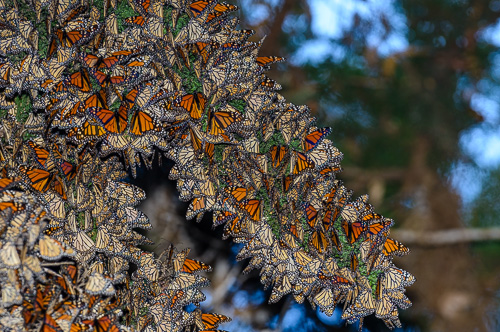
Butterflies flit
that is all, amid the
field of sunlight…Basho

You can only stand, your neck craned, looking up into the trees at the thousands of Monarch butterflies (Danaus plexippus) clustered against the chill of winter. Looking like nothing more than branches covered with dead leaves until an errant breeze or ray of sunlight causes the brilliant orange and black wings to flash like stained glass.

Watching a butterfly flit from flower to flower on a warm spring or summer day I always sense the joy that must come with the power of flight. Although power doesn’t come to mind when watching a butterfly flouncing about like a petticoat in the breeze. Not like the power and joy that is obvious in the flight of Ravens playing on the wind.
Nonetheless butterflies fly with determination, at least the Monarch does during the migrations that take it as far as the interior of Mexico or the coast of California. Kinda hard to get my head around this simple fact, migrating butterflies. Of course birds migrate, some mammal species migrate, even tarantulas migrate a short distance so migration isn’t the problem, but butterflies? Yes, there are more butterfly species that migrate, Painted Ladies, some Skippers, the Mourning Cloak and others are known to escape the cold of winter or move when food sources become scarce. There are none like the Monarch or as well-known. There are two migration paths that these critters take. The most well known is the trek that takes them from Canada and the US east of the Rockies south into the mountains of Mexico. The other brings them from west of the Rockies and from western Canada to a number of sites along the coast of California. These migrations are generational on a seasonal basis.
Monarchs mate, the eggs hatch, the caterpillars feed on Milkweed the only thing they eat and transition into a chrysalis. The butterfly emerges from the chrysalis and flies on. Summer Monarchs (those that migrate) live for 6-8 weeks, those that form the wintering clusters are a different creature that lives for 6-8 months. Here is what no one knows, how do newly emerged butterflies know where they are going? There are no “old herd members” to pass on the landmarks needed for migration as we understand it. Scientists have discovered that Monarchs use a “time compensated compass” and a circadian clock in their antenna, so that may hint at the process. Now I believe in science and all that may mean but here is the reality in this mystery, it is simply a mystery. It is good to have things that we don’t understand, at least not completely. Things that make us just stand and marvel.
Monarchs are not on the Endangered Species list but they are in trouble and some think that this miracle of migration may disappear. The numbers of Monarchs that winter in the Oyamel Fir forest of Mexico have never been lower. In the mid 1990s they covered about 45 acres, this winter the area they wintered on was 1.6 acres. Last winter the area was about twice that. The numbers have had peaks and valleys ever since people have paid attention but the trend has been downward. The culprits are the usual, habitat loss, pollution, climate disruption and the biggie seems to be Big AGs insane love affair with GMO crops and the resultant massive herbicide use. Kill off the food supply you kill off the creature and that which depends on it.
The western population follows the same downward trend. At the Butterfly Grove at Pismo Beach, California back in the 1990-1991 season the number of Monarchs was about 230,000. This winter there were about 34,000 in January, and that number is somewhat better than the past few years.
For the period of late October through February there are overwintering clusters of Monarchs in a number of locations along the coast of California, Pismo Beach is one of the best to experience the event. In a grove of eucalyptus trees and a smattering of pines the Monarchs find the shelter they need to survive the winter before starting the trek back north and east. There are volunteers there to answer questions and provide a couple of spotting scopes to get a more intimate view of the butterflies.
Mornings are generally too cool for any of the Monarchs to bestir themselves but as the day warms some fly out to forage or drink water but many seem to fly for the pleasure of movement, not going anywhere. If you would like to photograph this gathering its pretty simple; find the clusters of butterflies, use a fairly long telephoto lens (we have used both a 200-400mm and a 500mm ’cause they are up in the trees), a flash with an extender is useful, especially on a cloudy day. Remember that a shorter telephoto could be helpful for that environment shot to give some context to the subject.
Here is a mystery that I can’t fathom, one of the worlds many. As Ed Abbey said regarding a plant he was contemplating in the desert “we know what it is called, we don’t know what it is”.
![Monarch Butterflies [Danaus plexippus]](https://pronghornwildlifephotography.files.wordpress.com/2014/03/inbf-0354.jpg?w=840)
![Monarch Butterfly [Danaus plexippus]](https://pronghornwildlifephotography.files.wordpress.com/2014/03/inbf-0382.jpg?w=840)
![Monarch Butterfly [Danaus plexippus]](https://pronghornwildlifephotography.files.wordpress.com/2014/03/inbf-0444.jpg?w=840)
![Monarch Butterflies [Danaus plexippus]](https://pronghornwildlifephotography.files.wordpress.com/2014/03/inbf-0521.jpg?w=840)
It must be wonderful to see these.
It is Bente, curiosity took us there and now I feel very fortunate to have taken the time and seen this amazing event.
Glad you stopped by.
Those photos are amazing – I’ve never seen anything like that.
Thanks for the kind words Lyle, we had never seen anything like this either. Always thought about a trip to Mexico to see them there, this just whets the appetite
for a trip down there.